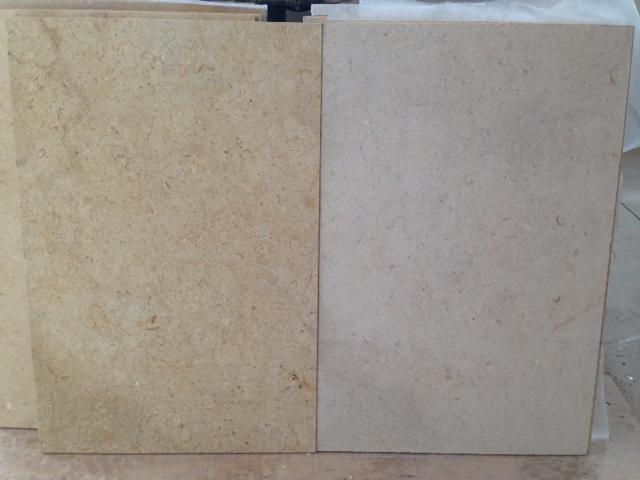Was due to get guys in to lay 60sq m of honed limestone on Monday ... when we discover that it is MUCH yellower than we wanted. Basically I think we looked at a tumbled version of this limestone, liked the colour, but went with honed (without checking sample) because we prefered cleaner, straighter grout lines and just assumed it would be same colour finish. Big mistake.
So ... in a big panic when we saw how yellowish this turned out to be. But when you look at the reverse of the stone, it's really nice and pale. So I guessed the yellowness must be from some sort of cheap sealant applied after the honing.
Sanded one of the tiles down using 40 grit sandpaper (I know, not exactly normal for stone etc.) ... but yes came up wonderfully pale! Rushed out to get some LTP Mattstone sealant (an impregnator, and reassuringly expensive at £17 per half litre thanks) ... but doh, back it goes to being yellow again.
These picture shows tile on left before sanding, and after sanding (ie. desired colour) on right. Does anyone therefore know a sealant that will produce the SMALLEST colour change possible? Desperate to buy something today ready for Monday ....!

So ... in a big panic when we saw how yellowish this turned out to be. But when you look at the reverse of the stone, it's really nice and pale. So I guessed the yellowness must be from some sort of cheap sealant applied after the honing.
Sanded one of the tiles down using 40 grit sandpaper (I know, not exactly normal for stone etc.) ... but yes came up wonderfully pale! Rushed out to get some LTP Mattstone sealant (an impregnator, and reassuringly expensive at £17 per half litre thanks) ... but doh, back it goes to being yellow again.
These picture shows tile on left before sanding, and after sanding (ie. desired colour) on right. Does anyone therefore know a sealant that will produce the SMALLEST colour change possible? Desperate to buy something today ready for Monday ....!



